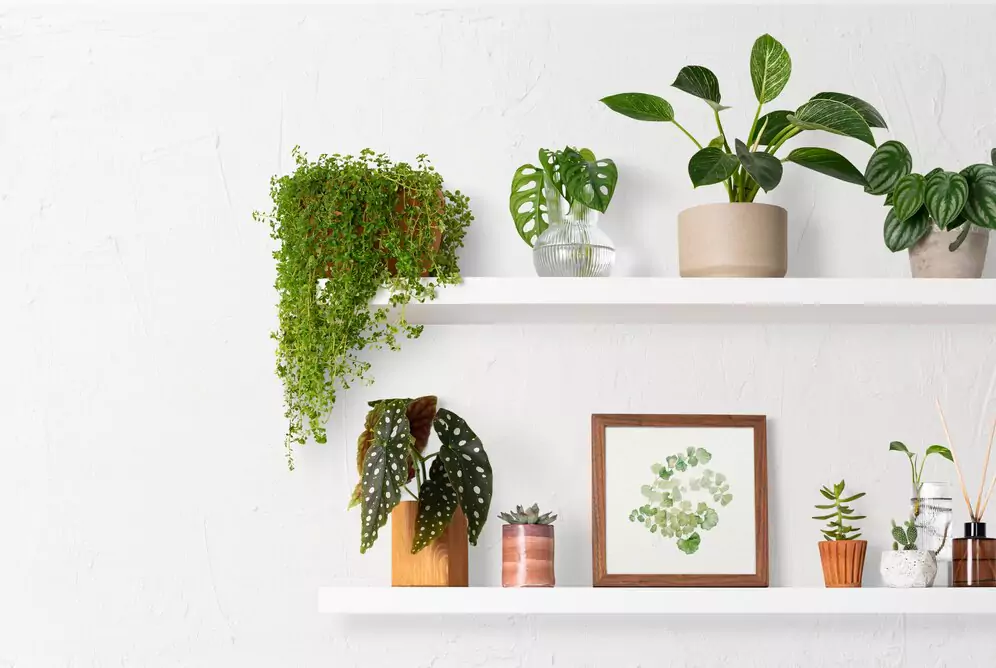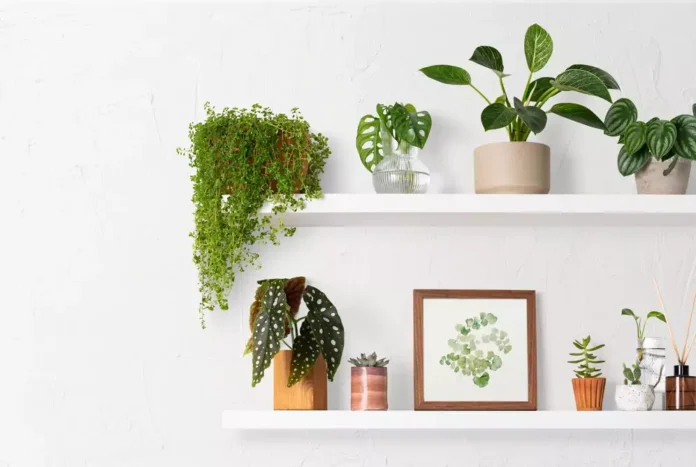Introduction
Indoor plants have long been known for their aesthetic appeal, but did you know that they can also have a positive impact on your mental health? Studies have shown that incorporating indoor plants into your living room decor can improve your mood, reduce stress and anxiety, and even improve the air quality in your home. In this article, we will explore the various benefits of indoor plants for your mental health and provide tips on how to choose the right plants for your living room.

The Benefits of Indoor Plants for Your Mental Health
Indoor plants have been found to have a number of benefits for mental health. Firstly, they can improve your mood by creating a calming and soothing environment. The presence of greenery has been shown to reduce feelings of anger, anxiety, and depression, and promote feelings of relaxation and happiness. This is due to the fact that plants release oxygen and absorb carbon dioxide, which can help to purify the air and create a more pleasant atmosphere.
Several studies have supported the claim that indoor plants can improve mental health. For example, a study published in the Journal of Environmental Psychology found that participants who were exposed to indoor plants reported lower levels of stress and anxiety compared to those who were not exposed to plants. Another study published in the Journal of Physiological Anthropology found that indoor plants can reduce blood pressure and heart rate, leading to a decrease in stress levels.
How Indoor Plants Can Help Reduce Stress and Anxiety
Indoor plants have been found to have a calming effect on the mind and body, which can help to reduce stress and anxiety. The presence of greenery has been shown to promote relaxation and create a sense of tranquility. This is because plants release chemicals called phytoncides, which have been found to reduce stress hormones and promote feelings of calmness.
Studies have supported the claim that indoor plants can reduce stress and anxiety. For example, a study published in the Journal of Environmental Psychology found that participants who were exposed to indoor plants experienced a significant reduction in stress levels compared to those who were not exposed to plants. Another study published in the Journal of Physiological Anthropology found that indoor plants can lower blood pressure and heart rate, leading to a decrease in stress levels.
The Science Behind Indoor Plants and Their Positive Effects on Your Mood
Indoor plants have been found to have a positive effect on mood. The presence of greenery has been shown to improve mood and create a sense of happiness and well-being. This is because plants release chemicals called volatile organic compounds (VOCs), which have been found to have a positive impact on mood.
Several studies have supported the claim that indoor plants can improve mood. For example, a study published in the Journal of Environmental Psychology found that participants who were exposed to indoor plants reported higher levels of happiness and well-being compared to those who were not exposed to plants. Another study published in the Journal of Physiological Anthropology found that indoor plants can increase serotonin levels, which are known to improve mood.
How to Choose the Right Indoor Plants for Your Living Room
When choosing indoor plants for your living room, it is important to consider factors such as lighting, temperature, and humidity. Different plants have different requirements, so it is important to choose plants that will thrive in your specific environment. Here are some tips for choosing the right indoor plants:
1. Consider the lighting conditions in your living room. Some plants require bright, indirect light, while others can tolerate low light conditions. Choose plants that will thrive in the available light.
2. Consider the temperature and humidity levels in your living room. Some plants prefer warm and humid conditions, while others prefer cooler and drier conditions. Choose plants that will thrive in your specific environment.
3. Consider the size and shape of your living room. Some plants grow tall and bushy, while others are more compact and trailing. Choose plants that will fit well in your living room and complement your existing decor.
The Top 10 Indoor Plants for Boosting Your Mood and Improving Your Decor
1. Snake Plant: The snake plant is known for its air-purifying properties and can help to improve the air quality in your home. It is also a low-maintenance plant that can thrive in a variety of lighting conditions.
2. Peace Lily: The peace lily is a beautiful plant that can help to reduce stress and anxiety. It is also known for its ability to remove toxins from the air, making it a great choice for improving indoor air quality.
3. Pothos: The pothos is a trailing plant that can add a touch of greenery to any space. It is also known for its ability to remove toxins from the air, making it a great choice for improving indoor air quality.
4. Spider Plant: The spider plant is a popular choice for indoor plants due to its low-maintenance nature and air-purifying properties. It is also known for its ability to remove formaldehyde from the air, making it a great choice for improving indoor air quality.
5. Aloe Vera: Aloe vera is not only a beautiful plant, but it also has a number of health benefits. It can help to improve air quality by removing toxins from the air, and it can also be used to treat minor burns and skin irritations.
6. Boston Fern: The Boston fern is a beautiful plant that can add a touch of elegance to any space. It is also known for its ability to remove toxins from the air, making it a great choice for improving indoor air quality.
7. Rubber Plant: The rubber plant is a popular choice for indoor plants due to its low-maintenance nature and air-purifying properties. It is also known for its ability to remove formaldehyde from the air, making it a great choice for improving indoor air quality.
8. English Ivy: English ivy is a trailing plant that can add a touch of greenery to any space. It is also known for its ability to remove toxins from the air, making it a great choice for improving indoor air quality.
9. ZZ Plant: The ZZ plant is a low-maintenance plant that can thrive in a variety of lighting conditions. It is also known for its ability to remove toxins from the air, making it a great choice for improving indoor air quality.
10. Chinese Evergreen: The Chinese evergreen is a beautiful plant that can add a touch of color to any space. It is also known for its ability to remove toxins from the air, making it a great choice for improving indoor air quality.
How to Care for Your Indoor Plants to Ensure They Thrive
Caring for indoor plants is essential to ensure that they thrive and continue to provide the mental health benefits you desire. Here are some tips for caring for your indoor plants:
1. Water your plants regularly, but be careful not to overwater them. Most indoor plants prefer to be kept slightly moist, but not soaking wet. Check the soil regularly and water when it feels dry to the touch.
2. Provide adequate lighting for your plants. Most indoor plants prefer bright, indirect light, so place them near a window where they can receive plenty of natural light. If you don’t have access to natural light, you can use artificial grow lights to provide the necessary light.
3. Monitor the temperature and humidity levels in your home. Most indoor plants prefer temperatures between 60-75 degrees Fahrenheit and humidity levels between 40-60%. If your home is too hot or too dry, consider using a humidifier or placing a tray of water near your plants to increase humidity.
4. Fertilize your plants regularly to provide them with the necessary nutrients. Use a balanced, water-soluble fertilizer and follow the instructions on the packaging for application rates.
5. Prune your plants regularly to remove dead or dying leaves and promote healthy growth. Use clean, sharp pruning shears and make clean cuts just above a leaf node.
6. Keep an eye out for pests such as aphids, mealybugs, and spider mites. If you notice any signs of infestation, treat your plants with an appropriate insecticide or try natural remedies such as neem oil or insecticidal soap.
How Indoor Plants Can Improve the Air Quality in Your Home
Indoor plants have been found to improve air quality by removing toxins and pollutants from the air. They do this through a process called phytoremediation, where they absorb harmful chemicals through their roots and convert them into harmless substances.
Several studies have supported the claim that indoor plants can improve air quality. For example, a study conducted by NASA found that certain indoor plants can remove common indoor air pollutants such as formaldehyde, benzene, and trichloroethylene. Another study published in the Journal of Toxicology and Environmental Health found that indoor plants can reduce levels of volatile organic compounds (VOCs) in the air.
The Role of Indoor Plants in Creating a Relaxing and Inviting Living Room
Indoor plants can play a significant role in creating a relaxing and inviting living room. The presence of greenery can create a sense of tranquility and bring a touch of nature indoors. This can help to create a calming and soothing environment that promotes relaxation and well-being.
When incorporating indoor plants into your living room, it is important to consider design principles such as balance, scale, and proportion. Choose plants that complement your existing decor and fit well within the space. Consider using different types of plants to create visual interest and texture. Place plants strategically throughout the room to create a sense of balance and harmony.
The Aesthetic Benefits of Incorporating Indoor Plants into Your Decor
In addition to their mental health benefits, indoor plants can also enhance the aesthetic appeal of your living room. The presence of greenery can add a pop of color and texture to any space, creating a visually pleasing environment.
When incorporating indoor plants into your decor, it is important to consider design principles such as color, texture, and shape. Choose plants that complement your existing color scheme and add visual interest. Consider using plants with different textures and shapes to create depth and dimension. Place plants in decorative pots or planters that match your decor style.
How to Style Your Indoor Plants to Enhance Your Living Room’s Ambiance
Styling indoor plants is an art form that can enhance the ambiance of your living room. Here are some tips for styling indoor plants:
1. Group plants together to create a focal point. Place several plants of varying heights and sizes together to create a visually appealing display.
2. Use different types of pots or planters to add visual interest. Consider using pots in different colors, shapes, and materials to create a unique and eclectic look.
3. Use plant stands or shelves to elevate your plants and create visual height. This can help to draw the eye upwards and create a sense of verticality in the space.
4. Incorporate trailing plants or vines to add movement and drama. Hang them from the ceiling or place them on high shelves to create a cascading effect.
5. Use decorative accessories such as rocks, pebbles, or moss to add texture and interest to your plant displays.
Conclusion
In conclusion, incorporating indoor plants into your living room decor can have a positive impact on your mental health. They can improve your mood, reduce stress and anxiety, and even improve the air quality in your home. By choosing the right plants, caring for them properly, and styling them effectively, you can create a relaxing and inviting living room that promotes well-being and enhances your overall decor. So why not bring a touch of nature indoors and reap the many benefits of indoor plants for your mental health?


